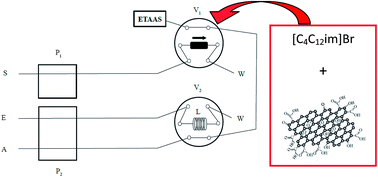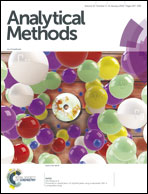An easily prepared graphene oxide–ionic liquid hybrid nanomaterial for micro-solid phase extraction and preconcentration of Hg in water samples†
Abstract
A preconcentration method based on the use of graphene oxide (GO) functionalized with an ionic liquid (IL) was developed for trace Hg determination in water samples. The IL–GO hybrid nanomaterial was prepared by a simple procedure to functionalize GO with the IL 1-butyl-3-dodecylimidazolium bromide ([C4C12im]Br) and its performance as a sorption material for Hg was evaluated. A microcolumn filled with the IL–GO nanomaterial was used for preconcentration and determination of Hg followed by electrothermal atomic absorption spectrometry (ETAAS) detection. Mercury was retained at pH 5.0 and 20% (v/v) HNO3 was used for the elution of Hg from the microcolumn. The effects of different variables, including the sample volume, extraction time, sample flow rate, type and concentration of eluent and eluent flow rate were carefully studied. High retention efficiency (100%) was achieved with the proposed IL–GO sorption nanomaterial without the need for additional chelating reagents or derivatization reagents, which is an important advantage compared with traditional preconcentration methods. A sensitivity enhancement factor of 100 and a low detection limit of 14 ng L−1 were obtained under optimal experimental conditions. The proposed method can be considered as a simple, cost-effective and efficient alternative for Hg determination in water samples like river, rain, mineral and tap water.



 Please wait while we load your content...
Please wait while we load your content...